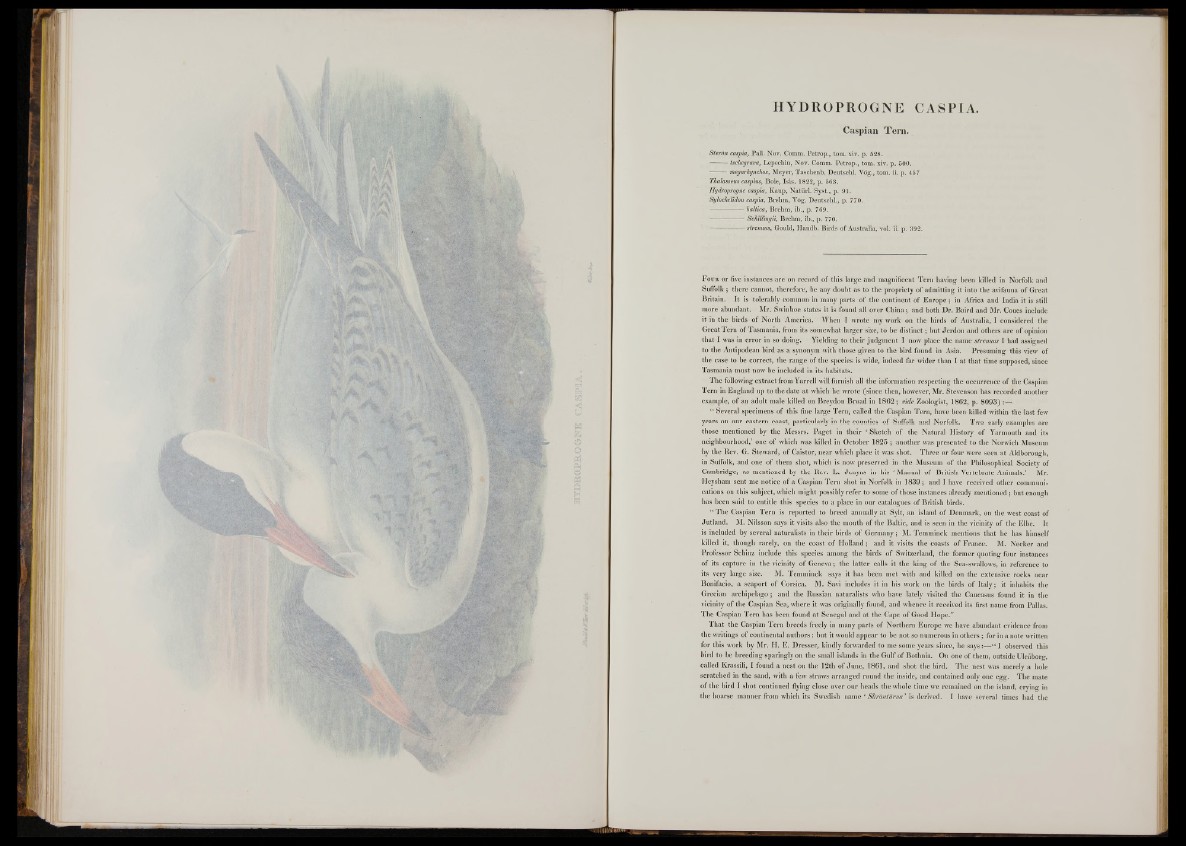
HYDROPROGNE CASPIA.
Caspian Tern.
Sterna caspia, Pall. Nov. Comm. Petrop., tom. xiv. p. 528.
tschegrava, Lepechin, Nov. Comm. Petrop., tom. xiv. p. 500.
:------ megarhynchos, Meyer, Taschenb. Deutschi. Vög., tom. ii. p. 457
Thalasseus caspius, Boie, Isis, 1822, p. 563.
Hydroprogne caspia, Kaup, Natürl. Syst., p. 91.
Sylochelidon caspia, Brebm, Yög. Deutscbl., p. 770.
----------- baltica, Brehm, ib., p. 769.
-at Schillingii, Brehm, ib., p. 770.
■----------- stremns, Gould, Handb. Birds of Australia, vol. ii. p. 392.
F o u r or five instances are on record o f this large and magnificent Tern having been killed in Norfolk and
Suffolk ; there cannot, therefore, be any doubt as to the propriety of admitting it into the avifauna o f Great
Britain. It is tolerably common in many parts o f the continent of Europe ; in Africa and India it is still
more abundant. Mr. Swinhoe states it is found all over China; and both Dr. Baird and Mr. Coues include
it in the birds o f North America. When I wrote my work on the birds o f Australia, I considered the
Great Tern o f Tasmania, from its somewhat larger size, to be distinct; but Jerdon and others are o f opinion
that I was in error in so doing. Yielding to their judgment I now place the name stremus I had assigned
to the Antipodean bird as a synonym with those given to the bird found in Asia. Presuming this view of
the case to be correct, the range o f the species is wide, indeed far wider than I at that time supposed, since
Tasmania must now be included in its habitats.
The following extract from Yarrell will furnish all the information respecting the occurrence o f the Caspian
Tern in England up to the date at which he wrote (since then, however, Mr. Stevenson has recorded another
example, o f an adult male killed on Breydon Broad in 1862; vide Zoologist, 1862, p. 8093) >
“ Several specimens o f this fine large Tern, called the Caspian Tern, have been killed within the last few
years on our eastern coast, particularly in the counties o f Suffolk and Norfolk. Two early examples are
those mentioned by the Messrs. Paget in their ‘ Sketch o f the Natural History o f Yarmouth and its
neighbourhood,’ one o f which was killed in October 1825 ; another was presented to the Norwich Museum
by the Rev. G. Steward, o f Caistor, near which place it was shot. Three or four were seen at Aldborough,
in Suffolk, and one o f them shot, which is now preserved in the Museum o f the Philosophical Society of
Cambridge, as mentioned by the Rev. L. Jenyns in his ‘ Manual o f British Vertebrate Animals.’ Mr.
Heysham sent me notice o f a Caspian Tern shot in Norfolk in 1839; and I have received other communications
on this subject, which might possibly refer to some of those instances already mentioned; but enough
has been said to entitle this species to a place in our catalogues o f British birds.
“ The Caspian Tern is reported to breed annually at Sylt, an island o f Denmark, on the west coast of
Jutland. M. Nilsson says it visits also the mouth o f the Baltic, and is seen in the vicinity of the Elbe. It
is included by several naturalists in their birds of Germany; M. Temminck mentions that he has himself
killed it, though rarely, on the coast o f Holland; and it visits the coasts o f France. M. Necker and
Professor Schinz include this species among the birds o f Switzerland, the former quoting four instances
o f its capture in the vicinity of Geneva; the latter calls it the king o f the Sea-swallows, in reference to
its very large size. M. Temminck says it has been met with and killed on the extensive rocks near
Bonifacio, a seaport o f Corsica. M. Savi includes it in his work on the birds o f Italy; it inhabits the
Grecian archipelago; and the Russian naturalists who have lately visited the Caucasus found it in the
vicinity o f the Caspian Sea, where it was originally found, and whence it received its first name from Pallas.
The Caspian Tern has been found at Senegal and at the Cape o f Good Hope.”
That the Caspian Tern breeds freely in many parts o f Northern Europe we have abundant evidence from
the writings o f continental authors : but it would appear to be not so numerous in others ; for in a note written
for this work by Mr. H. E. Dresser, kindly forwarded to me some years since, he says:— “ I observed this
bird to be breeding sparingly on the small islands in the Gulf o f Bothnia. On one o f them, outside Uleaborg,
called Krassili, I found a nest on the 12th o f June, 1861, and shot the bird. The nest was merely a hole
scratched in the sand, with a few straws arranged round the inside, and contained only one egg. The mate
o f the bird I shot continued flying close over our heads the whole time we remained on the island, crying in
the hoarse manner from which its Swedish name ‘ Skrautarna ’ is derived. I have several times had the